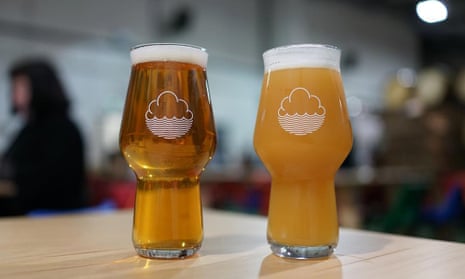For decades, there has been a transparent consensus among beer drinkers that a perfect pint must look crystal-clear. But as Britain begins to embrace murky beer, that shibboleth suddenly looks shaky.
From Cornwall’s Verdant Brewing to Pilot in Edinburgh, many UK breweries are now making opaque, milky-looking beers. “Murky” is a blossoming cult phenomenon, complete with its own backlash (#murkshaming) and ardent critics. Nonetheless, in craft beer bars, murk is fast becoming the new normal.
In Manchester, Cloudwater brewery produces an array of turbid beers that, far from the idealised pin-bright pint, resemble fruit juice, chicken stock or, naysayers snort, muddy water. You could take one look at a Cloudwater beer, (wrongly) deem it off and send it back. However, the firm’s Paul Jones says that among craft beer fans who no longer “drink with their eyes”, murky beer is “setting the marketplace alight”. Why? Flavour, basically. In recent years, breweries such as Moor and Kernel (a pioneer of early “London murky”) started to produce beers that dispensed with the fining and filtration traditionally used to clear beer. Those processes, they argued, suck out flavour.
Most UK craft brewers now make some hazy, unfiltered beers but, this year, murky has become a super-charged, transatlantic movement as more and more brewers look to New England-style IPAs for inspiration. NPR dubbed it, “the haze craze”. Less pointedly bitter than their west coast rivals, these east coast juice bombs are brewed with protein-rich wheat and oats, fruitier, hazy yeasts and are massively dry-hopped to create murky, silken beers that, packed with proteins and polyphenols, can take on a vivid, yellowy-orange glow. “New England is the most modern and approachable iteration of IPA,” says Jones. “It’s a luscious tropical fruit experience.”
Historically, murky real ale was a danger sign that a beer had not conditioned properly, that unpalatable yeasts had not settled or that your pint was full of end-barrel finings. However, most modern keg beers are unfined and, despite their appearance, murky beers often contain little yeast. But, traditionalists shoot back, how can you tell if a beer is intentionally cloudy or, somehow, off?
The advice from Patrick Jones, co-owner of Pilot (motto: “Hazy beers for bright people”), is trust your senses: “The idea was always: if a beer’s cloudy, it’s off. But you can smell if something is wrong with a beer. These are the freshest beers you’ll ever taste.” Those throwing shade at murky beer will despair both at the latest US trend for “milkshake IPAs” (some made with flour for maximum murk) and Cloudwater’s mango sour. It contains 25% fruit puree and looks more like a smoothie than a beer. Paul Jones is unperturbed by that visual dissonance: “If it tastes great, we don’t give a monkey’s.”
G2’s forecast for UK craft beer? The outlook is increasingly murky.
Three murky beers to try
Wylam Brewery Into the Mystic, 5.8% Hazy intro to the New England style.
Verdant Brewing I Played Bass On That Tune, 6.5% New, super-fruity “secret yeast” IPA.
Howling Hops Double IPA New England Special, 8.6% Murky amber, tropical hop bomb.

Comments (…)
Sign in or create your Guardian account to join the discussion